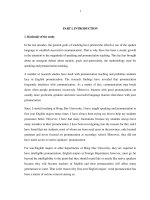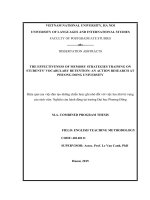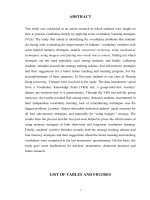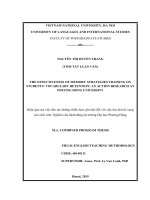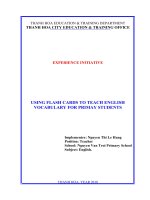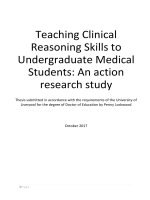Using songs to teach English vocabulary to Primary school children an action research at Dien Bien Primary school, Thanh Hoa province
Bạn đang xem bản rút gọn của tài liệu. Xem và tải ngay bản đầy đủ của tài liệu tại đây (178.17 KB, 4 trang )
Using songs to teach English vocabulary to
Primary school children: an action research at
Dien Bien Primary school, Thanh Hoa province
Hà Thị Thu Hương
Trường Đại học Ngoại ngữ
Luận văn Thạc sĩ ngành: English teaching methodology; Mã số: 60 14 10
Người hướng dẫn: M.A. Phùng Thị Kim Dung
Năm bảo vệ: 2012
Abstract. Teaching vocabulary must be easy and enjoyable for young learners so that
the students easily keep the new words in their mind. English teachers have to use good
technique in teaching vocabulary to young learners. There are many techniques used in
teaching English vocabulary to young learners. In this thesis, the writer uses songs as
the technique in teaching English vocabulary to primary learners. The aims of this
research are to find out the effectiveness of using songs to teach vocabulary to
elementary students and the learners’ responses toward this technique. To obtain the
data the writer conducted participant observations and delivered questionnaire to the
third grade students. The results of the study reveal that songs can be used effectively to
improve students’ English vocabulary and the students have very positive responses
toward this technique.
Keywords. Phương pháp giảng dạy; Từ vựng; Tiếng Anh
Content
1.1 Statement of the Problem
English is one of international languages, which is used throughout the world and in
many fields of life such as in Politics, Economics, Social and Education. Therefore, English as a
language in international communication is clearly needed by many learners to deliver thought
and interact in a variety of situations. Because of the importance of English, English has been
taught to students since they are in the Elementary school.
According to Yuliana (2003), teaching young learners is not like teaching adults
because children have their own way of learning. Since children like to play and have fun, the
learning and teaching process should be suited with the nature the children themselves. Larsen-
Freeman (2000) state that in teaching English to young learner context, children will learn a
foreign language more effectively under certain conditions.
As the basic components of the four language skills (listening, reading, writing and
speaking) vocabulary has to be mastered by learners. Vocabulary is the main point to learn
English. Without having adequate vocabulary we will get difficulty to learn English. In
Elementary School, vocabulary is the first step to learn English, because without knowing a lot
of vocabulary in English the children will get difficulties in mastering English. Thus, vocabulary
should be the first priority in English language teaching and learning.
To teach vocabulary in Elementary school, especially for children, is not an easy way.
Teaching children is different from teaching adults. We must have extra power to teach them,
because the children have certain characteristics and need certain treatment. Therefore, in
teaching vocabulary to young learners, it needs appropriate technique. According to Brown
(2001) technique is any of a wide variety of exercises, activities, or tasks used in the language
classroom for realizing lesson objective. In addition, in any kinds of language learning activities,
techniques may certainly constitute an indispensable factor that facilitates every successful effort
in vocabulary mastery. Therefore, we can say that techniques of teaching vocabulary to young
learners are important because it can help the students learn easier and enjoy the material
presented. Furthermore, some sources explain techniques in teaching vocabulary in elementary
school can be applied such as games, songs, memorization, dictation, etc. Among these
techniques, song is one useful technique to young learners because most children enjoy listening
to songs.
Many empirical works were done to prove the theoretical consideration above.
Purwoharto (2002) study about the vocabulary teaching techniques of the fourth class students at
MIN I Malang, Indonesia. The study was conducted to know what the techniques used by the
teacher and what the most appropriate technique to be employed by the teacher. The research
design used was descriptive qualitative design. The result of the study showed that the teacher
used two techniques in teaching vocabulary. The techniques were guessing pictures and singing a
song. Between those two techniques above, students were interested in singing a song. They
were very enthusiastic because they were free to express their styles and they felt happy.
In Vietnam, teaching English at primary school to children at grade 3 has been applied
since 2010. Two years after the implementation of English at primary level, there are many
problems of language teaching that can be identified as research subjects. We could discuss
about methods, material selection, and others. Some study had been done to explore the use of
modern equipments and techniques to find out the effective ways of teaching English to primary
school children. Vu Thi Luong (2002 cited in Do Thi Mai Chi, 2007) conducted a study on using
games in teaching English to primary school children. The research pointed out that game is a
useful teaching technique in primary English language teaching; however, the teachers had many
different opinions about them as well as difficulties in using them. 90% of teacher in the study
sample agreed that games are effective to language teaching but almost all of them complained
that they did not have any book about using games in teaching so they used only some games
repeatedly.
In this research it is identified that teaching technique for primary level is
challenging. Moreover, we know that technique in teaching vocabulary is important to help
students to increase their achievement in English. Therefore, the researcher intends to do a
research: “Using songs to teach English vocabulary to Primary school children: an action
research at Dien Bien Primary school, Thanh Hoa province”. The reason of choosing this
research is the researcher believes that song is a useful technique in teaching vocabulary that
supports the successful of learning and teaching process, especially to young learners who are
learning English.
1.2 Aims of the Study
This research is carried out with the hope that it could raise teachers’ awareness of using
song in teaching vocabulary and provide them a useful teaching technique. Through using song
in teaching, it could attract students’ interest in language learning. Based on that, it is hoped to
increase effectiveness of English teaching and learning process in Dien Bien primary school.
1.3 Objectives of the Study
The main purposes of the study are to find out the effectiveness of using songs to teach
vocabulary to elementary students and the learners’ responses toward this technique. The
statement of the problem can be formulated into the general research questions:
1. How effective is the use of songs in teaching vocabulary to elementary
students?
2. How are the learners’ responses toward the technique?
1.4 Scope of the Study
The research was carried out with no ambition to cover all problems over all Vietnamese
learners of English. Scope of the research is limited as it is only conducted on the students in the
third grade at Dien Bien Elementary school.
1.5 The Significance of the Study
The writer hopes that this study will be useful for teachers of elementary level.
Practically, it is hoped that this research will give the guideline how to teach and learn language
better, especially in vocabulary subject. So, the teachers themselves are expected to improve
their performance in teaching. Beside that, they are able to use songs as an appropriate technique
in teaching vocabulary.
Theoretically, this study is also expected to increase and enlarge the researcher’s
understanding in using teaching vocabulary techniques and help the other researchers to provide
information in mastering language components especially vocabulary.
References
Do Thi Mai Chi. (2007), Challenges of teaching English to primary students: Teachers’ Voices
from Ninh Binh, M.A thesis, University of International and Foreign Languages, VNU
Allen, Harold B. (1965), Teaching English as a Second Language: A Book of Reading, McGraw-
Hill, INC, United States of America.
Anderson, M and K. Anderson. (1997), Research and Education, Practice Hall, Inc, New Jersey.
Ary, Donald., Jacobs, L.C., & Razavieh, A. (2002), Introduction to Research in Education, Hult,
Rinehart and Winston, Inc, New York.
Bogdan, R.C., Biklen, S.K. (1992), Qualitative Research for Education: An Introduction to
Theory and Methods, Allyn and Bacon, Toronto.
Brown H. Douglas.(2000), Principles of Language Learning and Teaching, Wesley Longman,
Inc, San Fransisco State University.
Brown, Lewis and Hacleroad. (1969), Audio Visual Instruction, Mc. Graw, Hill Book Company,
New York.
Brumfit.C., Jane Moon and Ray Tongue. (1991), Teaching English to Children, Harper Colin,
London.
Burns, RB. (2000), Introduction to Research Method, Sage Publication, New Delhi.
Cameron, L. (2002), Teaching Language to Young Learners, Cambridge University Press, New
York.
Cameron, L. (2001), Teaching English to Young Learners, Cambridge University Press,
Cambridge.
Callahan Joseph F., Clark Leonard H.(1988), Teaching in the Middle and Secondary Schools:
Planning for Competence, Macmillan Publishing Company, New York.
Curtain, H. A. and Pesola, C. A. (1988), Language and Children – Making the Match, Addison-
Wesley Publishing Company, New York.
Evelyn Hatch and Cheryl Brown. ( 1995), Vocabulary, Semantic and Language Education,
Cambridge University Press, Cambridge, p.1
Edward, David Allen and Rebecca M, Vallete.(1997), Classroom Technique. Foreign Language
and English as a Second Language, Harcout Brave Javanovich, New York, P.149.
Harris, D P. (1969), Testing English as a Second Language, Mc.Graw-Hill Book Company, New
York.
Harmer, J. (2001), The Practice of English Language Teaching, Longman : Essex.
Harmer, J. (1978), Teaching Vocabulary, Longman : Essex.
Hellay. (1971), Teaching for Children, Practice Hall, Inc, New Jersey.
Mc Millan James H. (1992), Educational Research, Fundamentals for the Consumer, Harper
Collins Publisher, New York.
Larsen-Freeman, D. (1996), Techniques and Principles in Language Teaching, English
Teaching Forum, New York.
Murphey, T. (1992), Music and Song, Oxford University Press, Oxford.
Nation, I.S.P (1990), Teaching and Learning Vocabulary, Heinle & Heinle, Boston.
Nunan, D. (1992), Research Methods in Language Learning, Cambridge University Press,
Cambridge.
Phillips, Sarah. (1993), Young Learners, Oxford University Press.
Purwoharto. (2002), The Techniques of Teaching English Vocabulary, Malang, Unplublished
thesis.
Richards, Jack C & Rodgers, Theodore S. (2001), Approaches and Methods in Language
Teaching, Cambridge University Press, United States of America.
Scott, Wendy. A., & Ytreberg, L.H. (1990), Teaching English to Children, Longman, Inc, New
York.
Schmitt, N. (2000), Vocabulary in Language Teaching, Cambridge University Press,
Cambridge.
Schoepp, K. (2001), Reasons for using songs in the ESL/EFL classroom. Retrieved from
Songs.html
Slaterry, W and Willis, J. (2003), Teaching for Foreign Language, Oxford University Press,
New York.
Slattery, M. and Willis, J. (2001), English for Primary Teachers, Oxford University Press,
Oxford.
Sudijono, Anas. (2004), Pengantar Statistik Pendidikan, Jakarta: PT Raja Grafindo Persada,
Jakarta.
Vietnam Educational Publishing House & SNP Panpac Publishing House(2010), “Let’s learn
English book 1”, Hanoi.
Wallace, L; Marry. (1982), Vocabulary Building and Word Study, Mc.Graw-Hill Book
Company, New York.

